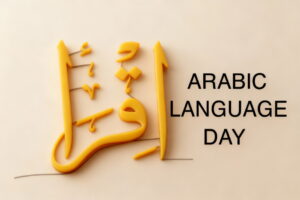
The Wonders of the Arabic Language!
The Arabic language is more than just a communication tool; it’s a linguistic marvel that bridges centuries, continents, and cultures. With over 400 million speakers worldwide, Arabic connects the Arab world from the Middle East to North Africa and has shaped intellectual, scientific, and artistic advancements for over 1,500 years.
Table of Contents
ToggleCognitive Wonders of Arabic
The Arabic Brain Effect:
Learning Arabic stimulates unique areas of the brain. Its right-to-left script, contextual letter shapes, and phonetic precision challenge cognitive processing and boost visual-spatial awareness, making it both intellectually engaging and neurologically beneficial.
The Root System Advantage:
Arabic is built on trilateral roots. From a three-letter base, an entire family of words blossoms. For example, the root ك-ت-ب (k-t-b) gives us:
- كتاب (kitāb) – book
- كاتب (kātib) – writer
- مكتبة (maktaba) – library
This logical system enables learners to connect meanings and guess new words intelligently.
Structural Marvels
1. The Dual Number Mystery
One of Arabic’s rarer grammatical gems is the dual form. While many languages distinguish between singular and plural, Arabic includes a special form for exactly two items:
- طالبان (ṭālibān) – two students
- بنتان (bintān) – two girls
It’s a fascinating example of how Arabic can express specific meanings efficiently.
2. Time-Traveling Verbs
Unlike English, Arabic focuses on whether an action is completed rather than when it occurred. This aspectual approach allows speakers to express time more flexibly and with nuance. A completed action uses one form, while ongoing or habitual actions use another—opening deeper storytelling possibilities.
- He wrote (finished) – كتبَ – kataba – He wrote
- He is writing / writes – يكتبُ – yaktubu – He is writing / he writes
- She read – قرأتْ – qara’at – She read
- She is reading – تقرأُ – taqra’u – She is reading
The verb form kataba (كتب) doesn’t always mean “past tense” as in a calendar-based concept—it means the action is done. On the other hand, yaktubu (يكتب) signals that the action is happening now or repeatedly.
Future Without “Will”
Arabic often uses context and prefixes instead of auxiliary verbs like “will.” To say “he will write,” you simply say:
- سَيَكْتُبُ (sayaktubu) – “He will write” Here, سَـ (sa-) is the future particle attached to the verb.
Another common structure is:
- سوفَ يكتبُ (sawfa yaktubu) – “He will write,” with stronger emphasis on the future.
Habitual or Timeless Action
The imperfect form also describes habitual actions, similar to the English simple present:
- أذهبُ إلى المدرسة كل يوم (adhhabu ilā al-madrasa kulla yawm) – “I go to school every day.”
Here, the verb adhhabu is not tied to present moment only—but rather to a recurring pattern.
Arabic’s Global Footprint
1. The Spanish Connection
Arabic’s influence on Spanish stems from centuries of interaction during the Andalusian period. Words like azúcar (sugar), almohada (pillow), and albahaca (basil) all originate from Arabic. This rich legacy lives on in Spain’s architecture, vocabulary, and place names.
2. African Linguistic Blends
In East Africa, Arabic mixed with Bantu languages to form Swahili. Words like “salaam” (peace) and “kitabu” (book) are direct borrowings, showing how Arabic helped shape regional identities and communication systems.
3. The English Connection
During the Islamic Golden Age (8th–13th centuries), Arabic was the language of science, medicine, astronomy, and mathematics. Through translations by scholars in Andalusia and Sicily, Arabic terms entered Latin and later English. Common English words of Arabic origin include:
- Algebra from al-jabr (الجبر) – “reunion of broken parts”
- Sugar from sukkar (سكر)
- Coffee from qahwa (قهوة)
- Cotton from quṭn (قطن)
- Admiral from amīr al-baḥr (أمير البحر) – “commander of the sea”
These examples show how Arabic shaped the vocabulary of science, trade, and everyday life in Europe—an influence still visible today in the English language.
Technological Wonders
Arabic’s AI Challenge:
Modern AI systems struggle with Arabic because of its morphological richness, vowel omission in writing, and the wide variety of spoken dialects. These complexities push technology firms to innovate, making Arabic a test case in computational linguistics.
The Unicode Odyssey:
Digitizing Arabic required new solutions in character encoding due to the language’s right-to-left direction, connected letter forms, and optional diacritical marks. This journey has made Arabic a milestone script in the world of digital text.
4 Arabic wonders untold secrets
The number of words in the Arabic language is 12,302,912 without repetition. That is, more than 20 times the number of English words, 600,000 words, and this linguistic indicator indicates the richness of the Arabic language compared to other languages. Here are some wonders of such a rich language:
- Every word that begins with the letter (kaf / K in English) often gives the meaning of containment, such as: “a bag, a planet, a cave, a shroud, a palm …etc.”.
- Every word that begins with the letter (Ghain / gh in English) often gives the meaning of ambiguity and lack of clarity, such as: “Cloud, clouds, dust, treachery (it means the enemy’s lack of clarity), stupid (who is the fool, the one to whom nothing is clear and who does not distinguish between right and wrong).
- Every word that contains two letters (Jim / G in English and Noon / N in English) gives the meaning of concealment, such as: “The fetus, the jinn, the garden, and it is the earth that is surrounded by trees, so what is inside it does not appear, the mad person, and he is the one whose mind is hidden and concealed.”
- One of the wonders is what is called “Nahat”, which is that some letters, however combined, give one meaning, such as: The letters “B H R”, however they are combined, give the meaning of hugeness and breadth (sea, ink, war).
AlBaher’s Wonder-Based Curriculum
Roots & Branches Program at AlBaher
This curriculum helps students dissect words to recognize roots and patterns. It builds intuitive vocabulary skills, letting learners grasp new terms faster through deductive logic.
Dual Number Bootcamp
Using real-life scenarios like ordering coffee or describing objects, students practice the dual form until it becomes second nature. It’s one of the unique features that deepens grammatical understanding.
Digital Arabic Lab
Our tech-enhanced learning space includes dialect-mapping tools and historical script comparison. These let students explore how Arabic changed across centuries—and regions—through a hands-on digital experience.
Arabic is not just a language. It’s a system, a story, and a marvel that continues to inspire learners, linguists, and technologists alike.



